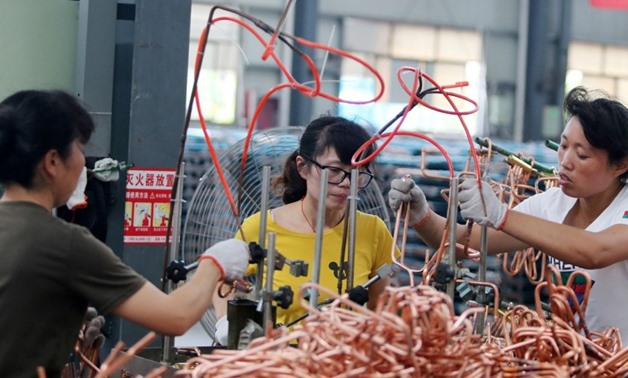
China’s factory output slowed more than expected in July while investment and retail sales also disappointed, reinforcing concerns that the world’s second-largest economy was starting to lose some steam as lending costs rose anChina’s factory output slowe
BEIJING – 6 November 2017: A burst of Chinese data over the next few weeks is expected to show the world’s second-biggest economy cooled further in October as policy makers harden efforts to reduce financial risks and foster long term sustainable growth.
That strategy was amplified at the recently-concluded Communist Party Congress by Chinese President Xi Jinping, who set the tone for policy by emphasizing quality over quantity in boosting economic growth and pledging to win the war on pollution.
While the government splurged on infrastructure projects, keeping fiscal policy fairly loose and stoking surprisingly strong growth through the year, authorities have also ramped up efforts to reduce China’s years-long addiction to debt.
“We expect growth to slow in October,” said Wendy Chen, an economist for Nomura in Shanghai.
Chen expects the gradual slowdown to extend through to the end of the year as pollution curbs hit factory output and weaker property and infrastructure spending cool investment growth.
Indeed, growth in factory output is seen slowing to 6.3 percent year-on-year in October from September’s 6.6 percent, according to a Reuters poll of 32 economists.
The war on pollution was partly to blame for third quarter growth cooling slightly to 6.8 percent, from the first half’s 6.9 percent.
Yet those numbers defied market expectations for a sharper slowdown this year, as the government-backed construction boom drove up prices from cement to steel and glass in a boost to overall economic output.
And October data is again expected to show growth will easily hit Beijing’s 6.5 percent target for 2017 as surging profits see factories expanding output, albeit at a slower pace, and resilient consumer spending supports broad activity.
Policymakers could face a delicate balancing act over the next year, analysts say, as they target high-risk lending to firms and the property sector, while taking long-overdue steps to bring polluting factories to heel.
There are some mixed signals about how strict this winter’s anti-pollution measures will actually be.
A government official on Tuesday said pollution measures in October hurt output at some firms, which was reflected in an official survey of the sector, while iron ore futures prices rose on Friday after production cuts at steel plants appeared to be less than expected.
Fixed-asset investment is predicted to have increased 7.4 percent in the Jan-Oct period, down slightly from a 7.5 percent rise in the first three quarters of the year.
Retail sales growth is seen edging up to 10.4 percent on-year from 10.3 percent the previous month.
Industrial output, fixed asset investment and retail sales data are set to be published on Nov. 14.
TRUMP AND TRADE
China is set to announce October trade data on Wednesday, the same day United States President Donald Trump arrives in Beijing for his first visit to China.
Trump has railed against China’s massive trade surplus with the U.S., and bilateral trade is set to feature prominently in discussions.
China’s trade surplus with the U.S. in September was the highest ever for any single month, based on Reuters calculations of official data going back to 2008, even as its overall surplus narrowed.
Economists expect China’s exports to have risen 7.2 percent on-year in October, slower than 8.1 percent the previous month, while imports may have jumped 16.0 percent, producing a trade surplus of $39.5 billion.
LOAN GROWTH TO SLOW
The governor of the People’s Bank of China Zhou Xiaochuan in comments over the weekend again warned about the risk from high leverage in China’s financial system, saying that China must prevent “black swan” events, which refers to major, unexpected occurrences.
Worries about a rapid build-up in China’s debt prompted S&P Global Ratings to downgrade China’s sovereign credit rating in September, following a cut by Moody’s in May.
China has mostly put the brakes on a buildup in corporate debt this year. Regulators have now also zoomed in on the risks from disguised property debt as investors look for ways around rules.
Economists expect that new loans in October dropped to a one-year low of 780 billion yuan ($117.59 billion) as banks restrict mortgage lending and corporates continue to shun bank loans.
Despite government rhetoric about the deleveraging drive, bank lending would have to drop sharply from this year’s trend for new loans not to surpass last year’s total and reach a new high.
The producer price index (PPI) is tipped to have risen 6.6 percent in October on-year, down from 6.9 percent in September when prices spiked on concerns supply would be short due to winter production restrictions.
The consumer price index (CPI) meanwhile is seen up 1.8 percent on-year in October, versus 1.6 percent in September.
China’s foreign exchange reserves are expected to have risen for a ninth month to $3.118 trillion in October, as capital curbs and a weakening dollar helped staunch fund outflows.
China is due to announce foreign exchange reserves data on Nov. 7, followed by trade and inflation data on Nov. 8 and Nov. 9 respectively, while loan and money data is expected anytime from Nov. 10 to Nov. 15.


Comments
Leave a Comment